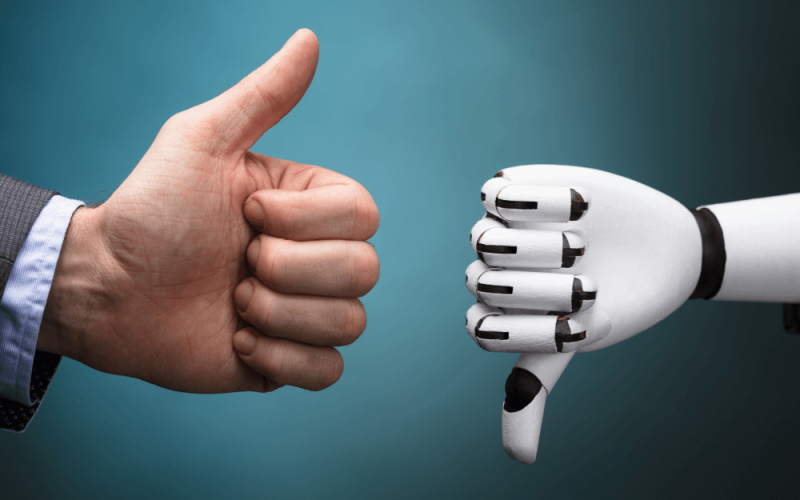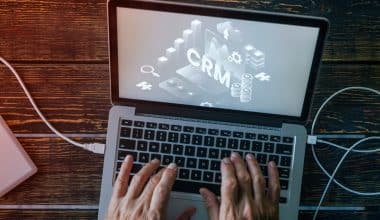When I initially started looking into the area of artificial intelligence, I was attracted by its promise. AI’s promise to revolutionize industries and make life easier was everywhere. However, as I delved deeper, I discovered some unpleasant truths that are rarely shared. In this piece, I’ll discuss nine alarming reasons why AI could be more dangerous than you realize. Let us look at these issues that every professional should be aware of.
Benefits of AI
Everyone understands that AI provides a competitive advantage for enterprises. According to the Appen State of AI Report for 2021, all firms must include AI and ML in their models or risk falling behind the curve. Companies are increasingly using artificial intelligence to streamline internal procedures (as well as customer-facing processes and applications). Implementing AI can help your company achieve its goals faster and with more precision.
#. Reduces human mistakes and danger
The first important advantage of using AI is that it reduces human mistakes and risks to humans.
“To err is human…” – Alexander Pope, an Enlightenment poet.
Everyone makes errors on occasion. That isn’t always a terrible thing, but when it comes to achieving consistent outcomes, it can be. Using AI to execute jobs, particularly repetitive ones, can keep human error from tarnishing an otherwise perfectly usable product or service.
Similarly, deploying AI to execute difficult or dangerous activities can help reduce the risk of human damage or harm. Robots employed in places with high radiation levels are one example of AI assuming risks in place of people. Radiation can cause serious illness or death in humans, but robots are unharmed. If a fatal error occurs, the robot can be rebuilt.
#2. Constant availability
AI algorithms are available at all times, whereas people labor eight hours every day. Machines can work all day and night, and AI-powered chatbots may give customer assistance even after hours. This can enable businesses to generate more and give a better customer experience than humans alone.
#3. Unbiased decision making
Humans disagree and allow their biases to seep into their conclusions all the time. Biases exist in all humans, and even when we strive to address them, they sometimes slip through the cracks.
On the other side, if the AI algorithm is trained on unbiased datasets and tested for programming bias, the program will be able to make decisions free of prejudice. This can help to increase equality in processes such as job application screening, loan approval, and credit application processing.
However, if the AI was formed using biased datasets or training data, it may produce biased decisions that are not detected because humans believe the decisions are neutral. That is why quality checks on training data and results from a given AI algorithm are critical to ensuring that bias issues are not overlooked.
#4. Repetitive jobs
Even the most intriguing job in the world involves some tedious or repetitive tasks. This could include tasks such as data entry and analysis, report generation, information verification, and so on. Using an AI computer can spare humans from the boredom of repetitive chores, freeing up their energy for more creative work.
#5. Decreased Costs
As previously discussed, AI can operate around the clock, producing more value in the same day as a human worker. Furthermore, because AI may assist in the automation of laborious and time-consuming operations, it frees up humans for more complex jobs. Finally, this adds value for the end user or consumer.
#6. Data collection and analysis
When it comes to data processing, the amount of data generated far outstrips humans’ ability to comprehend and evaluate it. AI algorithms can assist in processing large amounts of complex data, making it usable for analysis.
Reasons Why AI Is Bad
#1. Job Displacement
One of the most evident and direct effects of AI is job displacement. AI and automation are quickly displacing human labor across industries.
According to the World Economic Forum, AI and automation are anticipated to replace 85 million jobs by 2025.
I recall conversing with a friend who worked in a manufacturing facility. He was quite talented at his profession, but as the company implemented automated methods, he and several of his coworkers were laid off. This personal connection to the issue helped me recognize the human cost of AI breakthroughs.
While AI has the potential to create new jobs, the transition time can be terrible for traditional labor.
#2. Bias and Discrimination
The data on which AI systems are taught determines their effectiveness. Unfortunately, incorrect data can result in biased outcomes, exacerbating existing inequities.
According to an MIT study, facial recognition algorithms had a 34.7% mistake rate for darker-skinned women and 0.8% for lighter-skinned men.
I once tried an AI tool for recruitment, only to discover that it constantly preferred individuals with specific demographic criteria. This incident showed the potential biases that might be built into AI systems.
If AI is not rigorously monitored and rectified, it has the potential to perpetuate and even exacerbate societal bias.
#3. Privacy Concerns
AI’s ability to analyze massive volumes of data can raise serious privacy problems. Personal data are frequently exploited without explicit agreement, presenting ethical concerns.
According to a Pew Research Center survey, 79% of Americans are concerned about how businesses use personal information.
I was once targeted by an ad that seemed uncannily similar to a recent conversation I had. It turns out that the ad was served after an AI computer assessed my online activity. This incident made me realize just how much our privacy is at risk.
The invasive nature of AI in data analysis raises major privacy concerns that necessitate rigorous laws.
#4. Security Risks
In terms of cybersecurity, artificial intelligence can be a double-edged sword. While it can improve security, it can also be used maliciously.
According to research published by the European Union Agency for Cybersecurity (ENISA), AI-driven cyberattacks are on the rise and have the potential to do enormous damage.
During a cybersecurity session, I learned about AI-powered phishing assaults that adapt and change in real-time, making them practically hard to detect using conventional approaches. This emphasized the increasing sophistication of AI in cyber threats.
AI’s role in cybersecurity is a never-ending arms race, with both defensive and offensive capabilities.
#5. Ethical Dilemmas
AI raises several ethical concerns, notably in sectors such as healthcare, law enforcement, and combat.
According to the Brookings Institution survey, 61% of Americans are concerned about the ethical implications of artificial intelligence in decision-making processes.
I once took part in a debate regarding the employment of artificial intelligence in autonomous weaponry. The ethical implications were substantial, and it became evident that there are no simple answers to AI’s role in life-or-death decisions.
The ethical implications of AI necessitate careful consideration and strong frameworks for its development and deployment.
#6. Dependency and Loss of Skill
As AI becomes more interwoven into our daily lives, there is a risk of overdependence, which can lead to the loss of important abilities.
According to McKinsey & Company, by 2030, the majority of human-performed tasks could be automated.
I’ve discovered that relying on AI technologies for chores like navigation and scheduling has decreased my proficiency in these areas. This reliance may weaken the human ability to function without AI aid.
While AI can boost productivity, overreliance can lead to skill deterioration and increasing dependence.
#7. Lack of Accountability
When AI systems fail or do harm, it can be difficult to determine who is responsible. Who is responsible: the developer, the user, or the AI itself?
The Royal Society of Arts emphasizes that the lack of accountability in AI systems is a major worry, complicating legal and ethical responsibilities.
I have worked on a project using an AI system that made an inaccurate choice, resulting in financial damages. The blame was difficult to identify, emphasizing the importance of explicit accountability mechanisms in AI adoption.
Clear accountability in AI systems is critical for addressing failures and mitigating risks.
#8. Economic Inequality
AI has the potential to exacerbate the wealth and power gap by allowing people in possession of AI technologies to gain more riches.
According to the World Bank, automation and artificial intelligence may aggravate economic inequality by concentrating wealth in the hands of technology owners.
Conversations with colleagues revealed that access to advanced AI tools and technology is frequently restricted to larger firms, placing smaller enterprises and individuals at a disadvantage.
Addressing economic inequality in the age of AI necessitates policies that enable equal access to technology.
#9. Existential Risk
Some researchers fear that powerful AI may offer grave hazards to humans, particularly if AI systems become uncontrollable.
Renowned physicist Stephen Hawking has warned that if artificial intelligence is not properly handled, it could lead to the extinction of the human race.
While working on AI projects, I often considered the long-term ramifications. The concept that AI could outperform human intelligence and behave autonomously is both intriguing and terrifying.
Mitigating existential dangers necessitates proactive strategies, ongoing research, and ethical considerations in AI development.
Artificial Intelligence Use Cases
There are numerous potential applications of artificial intelligence in business. We discussed how AI might assist automate monotonous jobs, freeing up human workers to work on more complicated tasks. Other usage cases include:
- Early illness detection in healthcare utilizes artificial intelligence that analyzes patterns and data to forecast when and how a patient will acquire a specific disease.
- Customer service virtual assistant chatbots can handle simple and common requests while also assisting in the routing of more complex requests to human resources. These also contribute to providing assistance during off-hours and weekends.
- Fraud in financial institutions can be detected early on. The AI examines fraud trends to detect it as early as possible and prevent it from occurring altogether.
- Predictive analysis is created to assist businesses in projecting future possibilities, thereby preventing poor decisions and supporting excellent ones.
Key Takeaways
- AI and automation are expected to displace 85 million jobs by 2025, significantly impacting traditional labor markets and causing challenges for those seeking new employment opportunities.
- AI systems can perpetuate existing biases in their training data, leading to discriminatory outcomes.
- AI’s capability to analyze extensive data raises serious privacy concerns, with many people worried about how their personal information is used.
- AI introduces complex ethical dilemmas, particularly in sectors like healthcare and law enforcement.
- The potential for AI to evolve beyond human control poses existential risks. Increasing dependence on AI for tasks can also lead to a loss of essential skills among humans, diminishing their capabilities over time.
Conclusion
Understanding the possible risks of AI is critical as we advance in this technological era. By resolving these concerns, we can reap the benefits of AI while reducing its risks. Have you faced any of the following AI challenges? What actions are you taking to address them? Let’s continue the debate in the comments section below.
Related Articles
- Free PR Tools: Top 10 Free PR Gems That Put Paid Tools to Shame
- PR Tools: Our Best 15 Picks for 2024 (Free & Paid)
- The Best SEO Automation Software Tools for 2024
- AI Press Release: Generator Picks & How to Write Guide
- How To Humanize an AI Content






